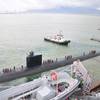U.S.-Asia Crude Exports Stall on Cheap Mideast Oil
Asian refiners shift towards cheaper Mideast oil, naphtha-trade; U.S. light oil exports to Asia only started 4 months ago. U.S. exports now going to Europe instead.
An aggressive strategy by Mideast Gulf producers to exploit the lowest oil prices in five years to defend market share is showing signs of bearing fruit as U.S. crude exports to Asia grind to halt.
Asian refineries have suspended imports of condensate, a light crude oil produced from the U.S. shale boom, just four months after they began in favour of cheaper Middle East grades, according to trade and industry sources.
The suspension illustrates how competition between suppliers has heated up following a more than 40 percent decline in oil prices since June.
Last week Ali al-Naimi, the oil minister of OPEC kingpin Saudi Arabia, warned his fellow OPEC members they must combat the U.S. shale boom. He argued against cutting OPEC production so as to keep prices depressed and undermine the profitability of North American producers.
"There's so much oversupply that Middle East crudes are now trading at discounts and it is not economical to bring over crudes from the U.S. anymore," said Tushar Tarun Bansal of consultancy FGE in Singapore.
U.S. oil became uncompetitive against similar grades from Qatar, Saudi Arabia and the United Arab Emirates after Gulf producers began dropping prices in August to maintain their market share in an oil market glut.
Crude oil prices have fallen more than 40 percent since June and the market tumbled further last week after OPEC, largely dictated by its Gulf members, decided at a meeting in Vienna against cutting output in order to support market share instead of prices.
Middle East crude currently accounts for about two-thirds of Asia's imports.
Adding to pressure on U.S. crude exports to Asia, freight rates from the United States to Asia have risen by 50 percent, forcing sellers to market their cargoes to Europe instead. This is partly due to higher demand for ships in the Middle East and Africa.
40-YEAR BAN STALLS TO ASIA
The United States eased a 40-year-old ban on crude exports last year in the wake of its shale oil boom, opening up new trade routes for surplus flows to Asia and Europe this year.
U.S. exports of lightly processed condensate, also known as light oil, started arriving in Asia in August and exports doubled to about 600,000 barrels in October.
Royal Dutch Shell bought the last cargo coming to Asia, due to arrive at its Singapore refinery in December, but as a result of the price shifts no more cargoes are expected to head east for at least the next two months, three traders who specialise in the market said.
The pressure could undermine plans to send further U.S. condensate to Asia. BHP Billiton Ltd and Enterprise Products Partners have both issued tenders to sell condensate next year.
Trading house Vitol, which bought the latest U.S. condensate cargo to load in December, is likely to send it for use at its Swiss refinery instead of Asia, trade sources said.
Vitol does not comment on its trading activities and Shell declined to comment.
Although U.S. light crude exports to Asia may have stalled for the moment, analysts say the new trade route is not necessarily dead for good.
"OPEC could still act in 2015, especially if prices fall too far (and) lower prices may spur non-OPEC exporters into action," Morgan Stanley said in a research note.
"Lower prices may only force U.S. producers and service companies to innovate even faster, pushing down the cost of production," the U.S. bank added.
By Florence Tan











